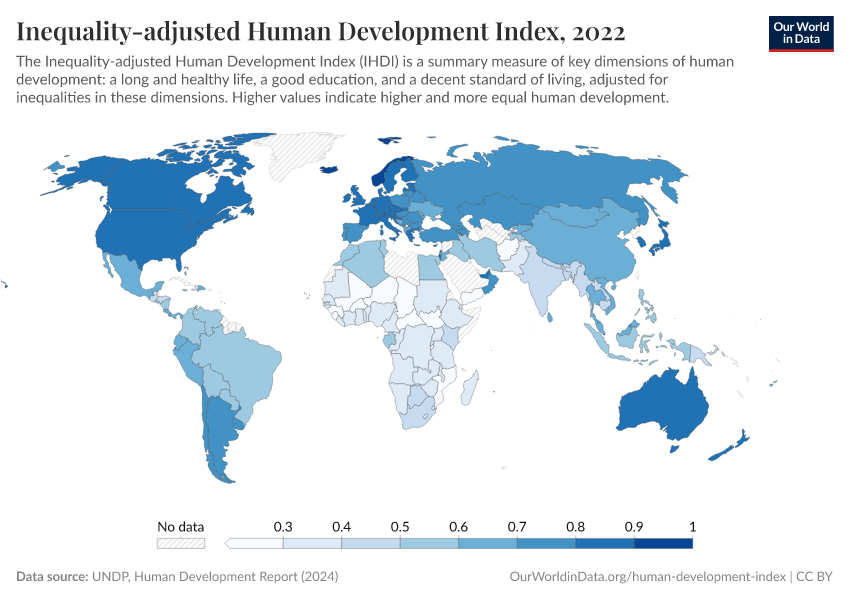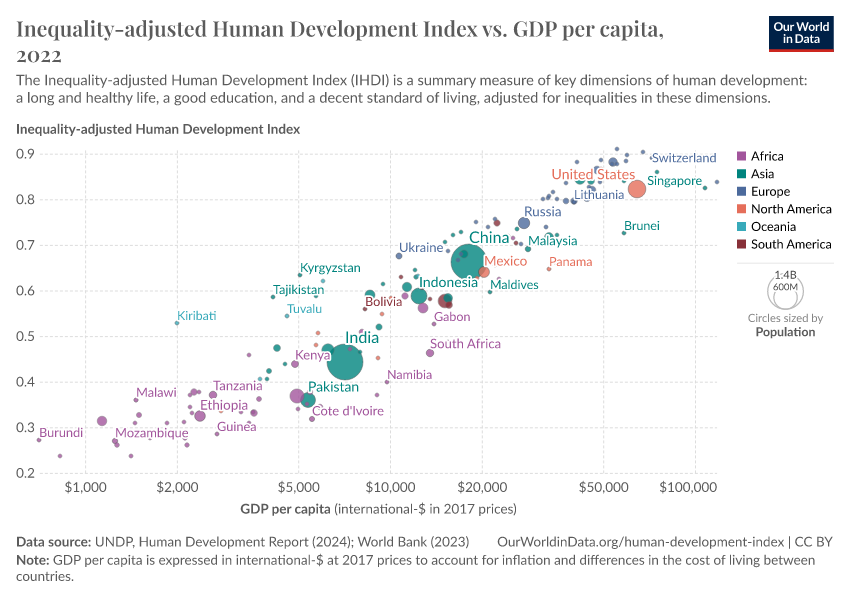Inequality-adjusted Human Development Index

What you should know about this indicator
- The Inequality-adjusted Human Development Index (IHDI) adjusts the Human Development Index (HDI) for inequality in the distribution of each dimension across the population.
- It is based on a distribution-sensitive class of composite indices proposed by Foster, Lopez-Calva and Szekely (2005), which draws on the Atkinson (1970) family of inequality measures. It is computed as a geometric mean of inequality-adjusted dimensional indices.
- The IHDI accounts for inequalities in HDI dimensions by “discounting” each dimension's average value according to its level of inequality. The IHDI value equals the HDI value when there is no inequality across people but falls below the HDI value as inequality rises. In this sense the IHDI measures the level of human development when inequality is accounted for.
Related research and writing
Sources and processing
This data is based on the following sources
How we process data at Our World in Data
All data and visualizations on Our World in Data rely on data sourced from one or several original data providers. Preparing this original data involves several processing steps. Depending on the data, this can include standardizing country names and world region definitions, converting units, calculating derived indicators such as per capita measures, as well as adding or adapting metadata such as the name or the description given to an indicator.
At the link below you can find a detailed description of the structure of our data pipeline, including links to all the code used to prepare data across Our World in Data.
Notes on our processing step for this indicator
We calculated averages over continents and income groups by taking the population-weighted average of the countries in each group. If less than 80% of countries in an area report data for a given year, we do not calculate the average for that area.
Reuse this work
- All data produced by third-party providers and made available by Our World in Data are subject to the license terms from the original providers. Our work would not be possible without the data providers we rely on, so we ask you to always cite them appropriately (see below). This is crucial to allow data providers to continue doing their work, enhancing, maintaining and updating valuable data.
- All data, visualizations, and code produced by Our World in Data are completely open access under the Creative Commons BY license. You have the permission to use, distribute, and reproduce these in any medium, provided the source and authors are credited.
Citations
How to cite this page
To cite this page overall, including any descriptions, FAQs or explanations of the data authored by Our World in Data, please use the following citation:
“Data Page: Inequality-adjusted Human Development Index”, part of the following publication: Bastian Herre and Pablo Arriagada (2023) - “The Human Development Index and related indices: what they are and what we can learn from them”. Data adapted from UNDP, Human Development Report. Retrieved from https://ourworldindata.org/grapher/inequality-adjusted-human-development-index [online resource]How to cite this data
In-line citationIf you have limited space (e.g. in data visualizations), you can use this abbreviated in-line citation:
UNDP, Human Development Report (2024) – with minor processing by Our World in DataFull citation
UNDP, Human Development Report (2024) – with minor processing by Our World in Data. “Inequality-adjusted Human Development Index – UNDP” [dataset]. UNDP, Human Development Report, “Human Development Report 2023-2024” [original data]. Retrieved March 10, 2025 from https://ourworldindata.org/grapher/inequality-adjusted-human-development-index
